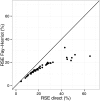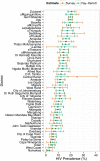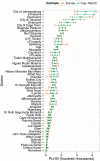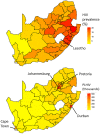Improving estimates of district HIV prevalence and burden in South Africa using small area estimation techniques
- PMID: 30794619
- PMCID: PMC6386240
- DOI: 10.1371/journal.pone.0212445
Improving estimates of district HIV prevalence and burden in South Africa using small area estimation techniques
Abstract
Many countries, including South Africa, have implemented population-based household surveys to estimate HIV prevalence and the burden of HIV infection. Most household HIV surveys are designed to provide reliable estimates down to only the first subnational geopolitical level which, in South Africa, is composed of nine provinces. However HIV prevalence estimates are needed down to at least the second subnational level in order to better target the delivery of HIV care, treatment and prevention services. The second subnational level in South Africa is composed of 52 districts. Achieving adequate precision at the second subnational level therefore requires either a substantial increase in survey sample size or use of model-based estimation capable of incorporating other pre-existing data. Our purpose is demonstration of the efficacy of relatively simple small-area estimation of HIV prevalence in the 52 districts of South Africa using data from the South African National HIV Prevalence, Incidence and Behavior Survey, 2012, district-level HIV prevalence estimates obtained from testing of pregnant women who attended antenatal care (ANC) clinics in 2012, and 2012 demographic data. The best-fitting model included only ANC prevalence and dependency ratio as out-of-survey predictors. Our key finding is that ANC prevalence was the superior auxiliary covariate, and provided substantially improved precision in many district-level estimates of HIV prevalence in the general population. Inclusion of a district-level spatial simultaneously autoregressive covariance structure did not result in improved estimation.
Conflict of interest statement
The authors have declared that no competing interests exist.
Figures




References
-
- Joint United Nations Programme on HIV/AIDS (UNAIDS). UNAIDS Data 2017; 2017. Available from: http://www.unaids.org/sites/default/files/media_asset/20170720_Data_book.... - PubMed
-
- Shisana O, Rehle T, Simbayi LC, Zuma K, Jooste S, Zungu N, et al. South African National HIV Prevalence, Incidence and Behavior Survey, 2012. Cape Town, South Africa: Human Sciences Research Council (HSRC) Press; 2014. Available from: http://www.hsrc.ac.za/en/research-outputs/ktree-doc/15031.
-
- Joint United Nations Programme on HIV/AIDS (UNAIDS). Ending the AIDS Epidemic by 2030; 2014. Available from: http://files.unaids.org/en/media/unaids/contentassets/documents/unaidspu....
-
- Office of the U S Global AIDS Coordinator. PEPFAR 3.0—Controlling the Epidemic: Delivering on the Promise of an AIDS-free Generation; 2014. Available from: https://www.pepfar.gov/documents/organization/234744.pdf.
Publication types
MeSH terms
Grants and funding
LinkOut - more resources
Full Text Sources
Medical

